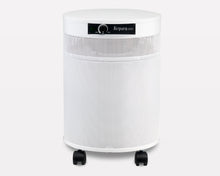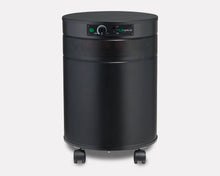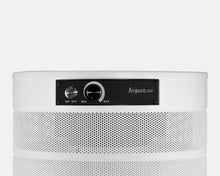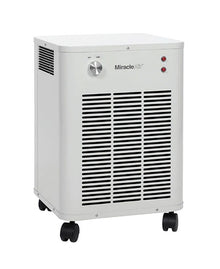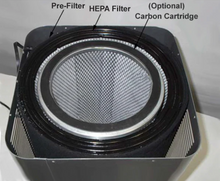Breathing Easy: Advanced Air Purification Strategies for High-Traffic Commercial Zones

In today's dynamic commercial landscape, the air we breathe indoors is more critical than ever. From bustling retail stores to energetic gyms, high-traffic commercial zones present unique challenges for maintaining optimal indoor air quality. As Commercial Air Purifiers, LLC, we understand that a healthy environment is not just about comfort; it's about safeguarding the well-being of customers and staff, enhancing operational efficiency, and building trust. This comprehensive guide will delve into the science behind airborne pathogen defense and explore advanced air purification strategies tailored for these vibrant spaces.
The Invisible Threat: Why High-Traffic Areas Need Superior Air Quality
Imagine a busy Saturday in a popular retail store or the peak hour at a fitness center. Hundreds, even thousands, of individuals move through these spaces daily, each exhaling countless microscopic particles. Among these are bioaerosols – tiny airborne particles that can carry bacteria, mold, yeast, and, crucially, viruses. The sheer volume of people in high-traffic commercial zones significantly amplifies the risk of airborne pathogen transmission.
The issue isn't just about direct coughs or sneezes. People release respiratory fluids during exhalation, from quiet breathing to vigorous exercise, in the form of droplets across a spectrum of sizes. While the largest droplets settle quickly, the smallest very fine droplets and aerosol particles can remain suspended in the air for minutes to hours, traveling considerable distances on ambient air currents. This means that an infected person, even if not exhibiting strong symptoms, can contribute to a widespread distribution of airborne pathogens throughout a commercial space.
The financial implications of poor indoor air quality extend beyond health concerns. Contamination can lead to increased absenteeism among staff, reduced productivity, and even direct impacts on product integrity in certain retail environments. For businesses, this translates to tangible financial burdens, from lost sales due to decreased foot traffic to potential legal liabilities. The need for robust air purification strategies isn't a luxury; it's a fundamental operational necessity.
The Science of Clean Air: Understanding Advanced Filtration
At Commercial Air Purifiers, LLC, we pride ourselves on understanding the intricate science behind effective air purification. Our expertise is rooted in deploying solutions that not only meet but exceed the evolving demands of commercial indoor air quality.
HEPA Filtration: The Gold Standard for Particle Capture
High-Efficiency Particulate Air (HEPA) filters are widely recognized as the gold standard for capturing airborne particles. These filters are designed to capture 99.97% of particles as small as 0.3 microns. To put that into perspective, most airborne viruses, including SARS-CoV-2 (the virus responsible for COVID-19), are smaller than 0.3 microns. However, viruses rarely travel alone; they are typically attached to larger respiratory droplets or aerosols, which HEPA filters are highly effective at trapping.
A study published in mSphere quantitatively demonstrated the effectiveness of HEPA filters in removing infectious SARS-CoV-2 from the air. The study found that an air cleaner equipped with a HEPA filter continuously removed the virus from the air, achieving capture ratios of over 99.97% with sufficient air changes. This highlights the critical role HEPA filtration plays in mitigating airborne viral loads in indoor environments.
UV-C Germicidal Irradiation: A Powerful Pathogen Inactivator
While HEPA filters physically remove particles, Ultraviolet-C (UV-C) germicidal irradiation offers an additional layer of defense by inactivating airborne pathogens. UV-C light at specific wavelengths (typically 254 nm) has been proven to disrupt the DNA and RNA of microorganisms, rendering them unable to replicate and cause infection.
Research has shown that UV-C can effectively inactivate viruses like SARS-CoV-2. A study published in Environmental Science & Technology Letters demonstrated that a commercial UV-C air purifier could significantly reduce airborne SARS-CoV-2. Another study in mSphere showcased the successful removal of SARS-CoV-2 bioaerosols using an air purification system combining UV-C light and HEPA filtration. When integrated into advanced air purification systems, UV-C technology provides a proactive approach to neutralizing pathogens as they pass through the unit.
Activated Carbon Filters: Tackling Odors and VOCs
Beyond biological contaminants, commercial spaces often contend with odors and Volatile Organic Compounds (VOCs) originating from cleaning products, building materials, and even human activity. Activated carbon filters excel in adsorbing these gaseous pollutants. The porous structure of activated carbon provides an immense surface area that traps chemical molecules, effectively removing unpleasant odors and harmful VOCs from the air.
For retail environments, maintaining a fresh and inviting atmosphere is paramount to the customer experience. In gyms, the combination of perspiration and cleaning chemicals can create persistent odors. Integrating activated carbon filtration ensures that the air is not just free of pathogens but also pleasant to breathe, contributing to overall customer satisfaction and comfort.
Tailored Air Purification Strategies for Retail Stores and Gyms
At Commercial Air Purifiers, LLC, we understand that a one-size-fits-all approach doesn't work. Retail stores and gyms have distinct operational needs and air quality challenges, requiring customized solutions.
Optimizing Air Quality in Retail Stores
Retail environments are characterized by fluctuating occupancy, varying floor plans, and a constant flow of new inventory which can off-gas VOCs. The primary goal for retail air purification is to create a consistently healthy and appealing atmosphere that encourages longer stays and repeat visits.
-
Strategic Placement and Sizing: For optimal effectiveness, air purifiers in retail stores should be strategically placed to ensure maximum air circulation and purification. Our experts at Commercial Air Purifiers, LLC, can conduct thorough assessments to determine the ideal number and placement of units, considering factors like square footage, ceiling height, and anticipated foot traffic. We often recommend a distributed approach, combining larger, centralized units with smaller, portable systems in specific high-traffic or problem areas.
-
Balancing Aesthetics and Performance: In retail, the visual appeal of the space is crucial. Modern commercial air purifiers are designed with aesthetics in mind, offering sleek, unobtrusive designs that can seamlessly integrate into various retail aesthetics without becoming an eyesore.
-
Addressing Specific Retail Pollutants: Beyond airborne pathogens, retail stores can experience dust from merchandise, VOCs from new product packaging or cleaning supplies, and general odors. A multi-stage filtration system incorporating pre-filters, HEPA, and activated carbon is essential to tackle this diverse range of pollutants.
-
Case Study Insight: A national clothing retailer partnered with Commercial Air Purifiers, LLC, to address persistent "new clothing" odors and improve overall air quality in their flagship stores. By implementing a system that combined high-CADR (Clean Air Delivery Rate) HEPA and activated carbon purifiers, they reported a significant reduction in odors and a noticeable improvement in customer feedback regarding the store environment. This led to increased dwell time and a more pleasant shopping experience.
Enhancing Air Filtration in Gyms and Fitness Centers
Gyms present a unique set of air quality challenges: intense physical activity leading to increased respiration rates, elevated humidity from sweat, and the potential for a higher concentration of airborne pathogens due to heavy breathing. The recommended air changes per hour (ACH) for health clubs is typically much higher than for other commercial spaces, often ranging from 20-26 ACH. This underscores the need for robust and highly efficient air filtration.
-
High-Capacity Systems for High ACH: Achieving the necessary air changes per hour in a gym requires powerful air purification systems capable of processing large volumes of air rapidly. Commercial Air Purifiers, LLC specializes in designing and implementing systems that meet these demanding requirements, ensuring a constant supply of clean air.
-
Targeting Bioaerosols and Odors: Given the nature of activity in gyms, prioritizing the removal of airborne viruses and bacteria is paramount. HEPA filters with integrated UV-C light technology are particularly effective in these environments. Additionally, strong activated carbon filtration is crucial for neutralizing odors associated with intense physical exertion and cleaning agents.
-
Duct-Based vs. Standalone Solutions: Depending on the gym's existing HVAC infrastructure, a combination of duct-based filtration upgrades and standalone air purifiers might be the most effective solution. Duct-based systems can enhance overall building air quality, while standalone units offer localized purification in areas like weight rooms, cardio zones, or studios where air circulation may be less uniform or where pathogen density might be higher.
-
Regular Maintenance for Peak Performance: Due to the high particulate load in gyms (dust, skin cells, textile fibers), regular maintenance and filter replacement are critical to ensuring the sustained efficiency of the air purification system. Commercial Air Purifiers, LLC offers comprehensive maintenance plans to ensure peak performance and longevity of your investment.
-
Real-World Application: A large chain of fitness centers observed a noticeable increase in member complaints about "stuffy" air and lingering odors. After consulting with Commercial Air Purifiers, LLC, they installed a series of industrial-grade air purifiers equipped with both HEPA and robust activated carbon filters throughout their facilities. Post-installation, member satisfaction surveys showed a significant improvement in perceived air quality, with many commenting on the freshness of the air. This not only improved the member experience but also reinforced the gym's commitment to member health and safety.
Actionable Steps for Businesses to Improve High-Traffic Air Quality
As Commercial Air Purifiers, LLC, we believe in empowering businesses with the knowledge and tools to create healthier environments. Here are practical steps you can take:
-
Assess Your Current Air Quality: The first step is to understand your baseline. Consider conducting an indoor air quality assessment to identify prevalent pollutants and determine current air change rates. This data will inform the most effective purification strategy.
-
Understand Air Changes Per Hour (ACH): This metric indicates how many times the entire volume of air in a space is replaced with new (or purified) air within an hour. For retail stores, an ACH of 6-10 is often recommended, while gyms may require 20-26 ACH. We can help you calculate your space's needs.
-
Invest in High-Efficiency Air Purification Systems: Look for systems that incorporate multi-stage filtration, including true HEPA filters (not "HEPA-type") and activated carbon. Consider units with integrated UV-C technology for enhanced pathogen inactivation, especially in high-density areas. The U.S. Environmental Protection Agency (EPA) emphasizes that air cleaners and HVAC filters can help reduce airborne contaminants, including viruses, when used properly alongside other best practices like ventilation.
-
Strategic Placement and Sizing: Work with experts, like those at Commercial Air Purifiers, LLC, to determine the optimal placement and sizing of air purification units for your specific layout and occupancy patterns. This ensures efficient air circulation and purification throughout the entire space.
-
Regular Maintenance and Filter Replacement: This is non-negotiable. Filters become less effective as they accumulate particles. Establish a strict schedule for filter checks and replacements to ensure your system continues to perform at its peak.
-
Integrate with Existing HVAC Systems: Air purifiers can complement your existing HVAC system. Upgrading HVAC filters to the highest efficiency possible (e.g., MERV 13 or higher) that is compatible with your system is an excellent first step, as recommended by the EPA, ASHRAE, and CDC. Standalone purifiers can then provide an extra layer of protection and targeted purification.
-
Monitor and Adapt: Consider implementing continuous air quality monitoring systems that track parameters like particulate matter (PM2.5, PM10), VOCs, and CO2. This data allows for real-time adjustments to ventilation and purification strategies, optimizing air quality based on occupancy and other fluctuating factors, aligning with the 2025 updates to indoor air quality standards emphasizing continuous monitoring.
The Commercial Air Purifiers, LLC Difference: Your Partner in Clean Air
At Commercial Air Purifiers, LLC, our mission is to empower businesses to create healthier, safer, and more productive environments through superior air purification solutions. Our team brings years of experience and expertise to every project, understanding the unique challenges faced by high-traffic commercial zones. We are committed to:
-
Experience: Our hands-on experience extends to numerous commercial installations, where we've seen firsthand the transformative impact of advanced air purification. We apply this practical knowledge to deliver tangible results for our clients.
-
Expertise: We stay at the forefront of air purification technology and research. Our solutions are backed by scientific understanding, leveraging the most effective filtration and inactivation methods available. We regularly consult recent studies from reputable organizations and integrate these insights into our recommendations.
-
Authoritativeness: We are a recognized leader in commercial air purification, offering solutions trusted by businesses across various sectors. Our recommendations are grounded in industry best practices and align with guidelines from authoritative bodies such as the EPA and ASHRAE.
-
Trustworthiness: Transparency and integrity are at the core of our brand. We provide clear, evidence-based recommendations, prioritizing the genuine health benefits for your occupants. We stand by the quality and efficacy of our products and services.
Conclusion: Investing in a Breath of Fresh Air
The quality of indoor air in high-traffic commercial zones is no longer a peripheral concern; it's a fundamental aspect of operational excellence and public health responsibility. By embracing advanced air purification strategies that integrate HEPA filtration, UV-C germicidal irradiation, and activated carbon, businesses can proactively defend against airborne pathogens and create environments that inspire confidence and promote well-being.
As Commercial Air Purifiers, LLC, we are dedicated to helping you navigate this critical aspect of facility management. Let us be your partner in ensuring that every breath taken within your retail store or gym is a breath of fresh, purified air.
Ready to elevate your commercial air quality? Contact Commercial Air Purifiers, LLC today for a personalized assessment and discover the ideal air purification solution for your high-traffic commercial zone.
FAQ Section
Q: How often do filters need to be replaced in a commercial air purifier for a high-traffic area? A: Filter replacement frequency depends on several factors, including the specific filter type, the size of the space, the level of airborne pollutants, and the operating hours. In high-traffic commercial zones like gyms and retail stores, filters may need to be checked and replaced more frequently than in less active environments. We typically recommend checking filters every 1-3 months and replacing them as needed, though our experts will provide a customized schedule based on your specific operational conditions and equipment.
Q: Are commercial air purifiers noisy? Will they disrupt the customer experience? A: Modern commercial air purifiers are designed to operate quietly, especially those engineered for high-traffic environments. While larger units may produce some ambient sound, it is typically comparable to a low hum and not disruptive to conversations or background music. Advances in fan technology and acoustic design prioritize minimal noise output, ensuring a comfortable environment for both customers and staff.
Q: Can air purifiers completely eliminate the risk of airborne pathogen transmission? A: While no single solution can guarantee 100% elimination of airborne pathogen transmission, advanced air purification systems, particularly those combining HEPA and UV-C technologies, significantly reduce the concentration of airborne viruses and bacteria. When used as part of a comprehensive strategy that includes good ventilation, regular cleaning, and proper hygiene practices, air purifiers provide a critical layer of defense, dramatically lowering the risk of transmission in high-traffic areas. The EPA states that air cleaning or filtration alone is not enough, but when used along with other best practices, filtration can be part of a plan to reduce the potential for airborne transmission.
Q: What is Clean Air Delivery Rate (CADR) and why is it important for commercial spaces? A: CADR (Clean Air Delivery Rate) is a measurement that indicates how quickly an air purifier removes pollutants from a room. It's measured in cubic feet per minute (CFM) for specific pollutants like smoke, dust, and pollen. For commercial spaces, a higher CADR is crucial as it signifies the unit's ability to purify a larger volume of air more rapidly, which is essential for maintaining optimal air quality in high-traffic environments with higher occupancy and air exchange requirements. Our specialists help businesses select purifiers with appropriate CADR ratings for their specific needs.
Q: What are the key differences between residential and commercial air purifiers? A: Commercial air purifiers are designed for much larger spaces, higher occupancy levels, and more demanding air quality challenges than residential units. They typically feature more powerful fans, larger and more robust filtration systems (often with multiple stages, including industrial-grade HEPA and activated carbon, and sometimes UV-C), and are built for continuous operation and durability. They also generally have higher CADR ratings to achieve the necessary air changes per hour for commercial settings.
Author Bio: Commercial Air Purifiers, LLC is a leading provider of advanced air purification solutions for businesses of all sizes. With decades of combined experience in indoor air quality management, our team of experts is dedicated to engineering and delivering state-of-the-art systems that protect health, enhance productivity, and promote environmental responsibility. We are committed to transparency, scientific rigor, and delivering tangible value to our clients, ensuring cleaner, safer, and healthier indoor environments for everyone.
Publication Date: July 4, 2025

